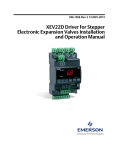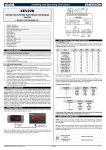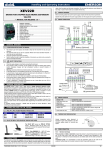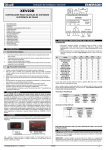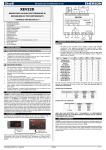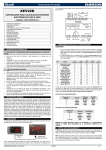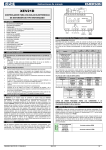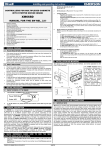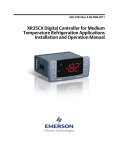Download Emerson XEV22D Specifications
Transcript
026-1206 Rev 0 09-FEB-2011 XEV22D Driver for Stepper Electronic Expansion Valves Installation and Operation Manual Retail Solutions 3240 Town Point Drive NW Suite 100 Kennesaw, GA 30144 Phone: 770-425-2724 Fax: 770-425-9319 ALL RIGHTS RESERVED. The information contained in this manual has been carefully checked and is believed to be accurate. However, Computer Process Controls, Inc. assumes no responsibility for any inaccuracies that may be contained herein. In no event will Computer Process Controls, Inc. be liable for any direct, indirect, special, incidental, or consequential damages resulting from any defect or omission in this manual, even if advised of the possibility of such damages. In the interest of continued product development, Computer Process Controls, Inc. reserves the right to make improvements to this manual, and the products described herein, at any time without notice or obligation. Table of Contents 1 INTRODUCTION.......................................................................................................................................................... 1 1.1. GENERAL WARNING ..................................................................................................................................................... 1 2 OVERVIEW ................................................................................................................................................................... 1 2.1. GENERAL DESCRIPTION ................................................................................................................................................ 1 2.2. ORDERING CODE ......................................................................................................................................................... 1 3 WIRING CONNECTIONS ........................................................................................................................................... 2 4 VALVE CONNECTIONS AND CONFIGURATION ............................................................................................... 3 5 ABSOLUTE MAXIMUM POWER ............................................................................................................................. 4 6 FRONT PANEL ............................................................................................................................................................. 5 6.1. KEYS AND FUNCTIONS ................................................................................................................................................. 5 6.2. XEV22D LEDS............................................................................................................................................................ 5 7 USER INTERFACE ...................................................................................................................................................... 6 7.1. 7.2. 7.3. 7.4. 7.5. 7.6. 7.7. TO SEE THE READ-ONLY VALUES ............................................................................................................................... TO SEE THE SETPOINT .................................................................................................................................................. TO MODIFY THE SETPOINT ........................................................................................................................................... TO ENTER PR1 PARAMETERS LIST ............................................................................................................................... TO ENTER PR2 PARAMETERS LIST ............................................................................................................................... TO MODIFY THE PARAMETERS VALUE ........................................................................................................................ HOW TO ASSIGN A MODBUS ADDRESS ..................................................................................................................... 6 6 6 6 6 6 7 8 PARAMETERS ............................................................................................................................................................ 8 9 DIGITAL INPUTS....................................................................................................................................................... 13 10 FORCED OPENING ................................................................................................................................................. 13 11 ELECTRICAL CONNECTIONS ............................................................................................................................ 14 11.1. PROBES ..................................................................................................................................................................... 14 12 RS485 SERIAL LINE ................................................................................................................................................ 14 13 HOW TO USE THE HOT KEY ............................................................................................................................... 15 13.1. HOW TO PROGRAM A HOT KEY FROM THE CONTROLLER (UPLOAD)...................................................................... 15 13.2. HOW TO PROGRAM THE CONTROLLER USING A HOT KEY (DOWNLOAD) ............................................................... 15 14 DISPLAY MESSAGES ............................................................................................................................................. 16 14.1. ALARM RECOVERY ................................................................................................................................................... 16 15 SPECIFICATIONS ................................................................................................................................................... 17 16 E2 MODBUS NETWORK WIRING ....................................................................................................................... 18 17 ECT MODBUS NETWORKING TO E2S .............................................................................................................. 19 17.1. E2 SETUP OF DEVICES .............................................................................................................................................. 17.1.1. Set Up Network Ports........................................................................................................................................ 17.1.2. Add and Connect the Device............................................................................................................................. 17.2. WIRING TYPES .......................................................................................................................................................... 19 19 20 21 Table of Contents • v 17.3. MODBUS TERMINATION BLOCKS ........................................................................................................................... 22 18 STANDARD VALUES ............................................................................................................................................. 23 vi • XEV22D I&O Manual 026-1206 Rev 0 09-FEB-2011 1 Introduction 2 Overview 1.1. General Warning 2.1. General Description Please read the following safety precautions and warnings before using this manual: The XEV22D controller is capable of driving a wide variety of stepper electronic expansion valves. The controller regulates the superheat (SH) of the fluid that runs into the refrigeration unit to obtain optimized performance and functioning of the evaporator independent of climate or load conditions. CAUTION! • This manual is part of the product and should be kept near the controller for easy and quick reference. • The controller should not be used for purposes different from those described in this manual. It cannot be used as a safety device. • Check the application limits before proceeding. SAFETY PRECAUTIONS AND WARNINGS! • Check that the supply voltage is correct before connecting the controller. • Do not expose to water or moisture: use the controller only within the operating limits and avoid sudden temperature changes with high atmospheric humidity to prevent condensation from forming. • Warning! Disconnect all electrical connections before performing any kind of maintenance. • Fit the probe where it is not accessible by the end user. The controller must not be opened. XEV22D controllers are equipped with two (2) probe inputs, one for a 4 to 20mA (or 0 to 5V) pressure transducer and another one for a Pt1000 or NTC temperature probe. The LAN connection transmits the pressure signal to the other XEVs; this allows the use of only one pressure transducer in multiplexed cabinet applications. The controller can also have two (2) configurable digital inputs, the first one is free of voltage and the other one is at high voltage, to simplify connections with cooling request signal. With the integrated display, it is possible to see the superheat (SH) value, the degree of valve opening, or the probe values; the local keyboard enables the controller to be programmed without any other devices. An RS485 serial link connects the controller to other Emerson monitoring and supervising systems. 2.2. Ordering Code • In case of failure or faulty operation, send the controller back to Retail Solutions (see address) with a detailed description of the fault. Device Name Dixell Code Emerson Code • Verify the maximum current that can be applied to each relay (see Section 15, Specifications). XEV22D XEV22D-1C0F0B X0JFGAESG3NA-000 318-5001 • Ensure that the wires for probes, loads, and the power supply are separated and far enough from each other, without crossing or intertwining. Table 2-1 - Product Ordering Code • In case of applications in industrial environments, the use of main filters (our mod. FT1) in parallel with inductive loads could be useful. General Warning Introduction • 1 3 Wiring Connections The superheat regulation is performed only when the cooling digital input is enabled. Figure 3-1 shows how the device takes the request of cooling: Figure 3-1 - How XEV22D Acts on Cooling Request See Figure 3-2 for wiring. The “First Level” indicates the connections on the floor of the 4-DIN module and “Second Level” indicates the connections on the first floor that are only for the stepper motor of the valve and for the Hot Key. Figure 3-2 - XEV22D Wiring Connections 2 • XEV22D I&O Manual 026-1206 Rev 0 09-FEB-2011 4 Valve Connections and Configuration CAUTION! To avoid possible problems, before connecting the valve configure the driver by making the right changes on the parameters. Select the kind of motor (tEU parameter) and check if the valve is present in the tEP parameter table reported below: tEP Model LSt (steps*10) uSt (steps*10) CPP (mA*10) CHd (mA*10) Sr (step/s) 0 Manual settings Par Par Par Par Par 1 Sporlan SEI 0.5-20 10 159 20 5 200 2 Sporlan SEI 30 20 319 20 5 200 3 Sporlan SEH 50-250 40 638 20 5 200 4 Alco EX5-EX6 10 75 40 10 450 5 Alco EX7 25 160 75 25 330 6 Alco EX8 330 step/s 25 260 80 50 330 7 Alco EX8 500 step/s 25 260 80 50 500 8 Danfoss ETS-25/50 20 262 14 8 120 9 Danfoss ETS-100 30 353 14 8 120 10 Danfoss ETS-250/400 35 381 14 8 120 Table 4-1 - tEP Parameter Table If you can locate your valve in the table, select the valve through the tEP parameter. This way, you can be sure of the correct configuration (refer to Table 4-1). Regarding connections, use Table 4-2 below for a quick reference on the connection mode for valves of different manufacturers. In any case, the unique and valid reference has to be considered the datasheet made by manufacturer of the valve: Connection Numbering ALCO EX* ALCO EX 5/6 SPORLAN SEI-SHE DANFOSS ETS 4 WHITE BLUE WHITE BLACK 2 YELLOW BROWN BLACK WHITE 3 BROWN BLACK RED RED 1 GREEN WHITE GREEN GREEN Table 4-2 - 4-Wire Valves (Bipolar) Ordering Code Valve Connections and Configuration • 3 5 Connection Numbering SPORLAN SAGINOMIYA 4 ORANGE ORANGE 2 RED RED 3 YELLOW YELLOW 1 BLACK BLACK 5- Common GRAY GRAY Table 4-3 - 5 to 6 Wire Valves (Unipolar) NOTE: After making the connection, switch the XEV controller OFF and ON to make sure that the valve is positioned properly. Absolute Maximum Power The XEV22D controller is capable of driving a wide range of stepper valves; listed in Table 5-1 are the maximum values of current that the actuator can supply to the stepper wiring. Use the TF20D transformer. NOTE: The electrical power absorption of the valve can be unrelated to refrigeration power that the valve has. Before using the actuator, read the technical manual of the valve supplied by the manufacturer and check the maximum current used to drive the valve to verify that they are lower than indicated below in Table 5-1. VALVE TYPE Bipolar Valves (4 Wires) Maximum Current 0.9A Uni-polar Valves (5 to 6 Wires) Maximum Current 0.9A Table 5-1 - Maximum Allowable Valve Current 4 • XEV22D I&O Manual 026-1206 Rev 0 09-FEB-2011 6 Front Panel By pressing and releasing this key, it is possible to see the values of the probes. In programming mode, it slides the codes of the parameters or increases their values. In programming mode, it slides the codes of parameters or decreases their values. Key Combinations To lock and unlock the keyboard. To enter programming mode. Table 6-1- XEV22D Front Panel Keys and Functions 6.2. XEV22D LEDS Each LED function is described in Table 6-2: LED Figure 6-1 - XEV22D Front Panel 6.1. Keys and Functions Table 6-1 shows the keys found on the front panel of the XEV22D and their corresponding functions: Key Mode ON Low pressure alarm ON Maximum operating pressure alarm OFF Valve is completely closed BLINKING ON Table 6-1- XEV22D Front Panel Keys and Functions Valve is moving Valve is completely opened BLINKING Serial communication present OFF Serial communication absent ON Superheat alarm Function To display and to modify the set point. In programming mode, it selects a parameter or confirms a value. Function Table 6-2 - XEV22D LEDs Keys and Functions Front Panel • 5 7 User Interface 7.1. To See the Read-Only Values 2. The device will display the first parameter in Pr1 menu. 7.5. To Enter Pr2 Parameters List To enter to Pr2 parameters list: 1. Press and release the UP arrow key. 2. The first read-only label is displayed. 3. Slide labels using the UP or DOWN arrow keys. 4. Press the SET key to see the read-only value. To change and view the parameter, press SET. 5. To exit the fast access menu, press and release the SET + UP arrow keys or wait for the device timeout for 3 minutes. 7.2. To See the Setpoint 1. Enter the Pr1 level menu. 1. Press the SET key until the setpoint is displayed. 2. Select Pr2 parameter and press SET. 2. To return and view the temperature, wait for 5 seconds or press the SET key again. 3. The PAS label will be displayed followed by a blinking 0. 7.3. To Modify the Setpoint To change the setpoint value, operate as follows: 1. Press the SET key until the set point is displayed. 2. Use the UP or DOWN arrow keys to change its value. 3. Press SET to store the new value. 7.4. To Enter Pr1 Parameters List To enter in Pr1 level menu: 4. Insert 321 password using the UP and DOWN arrow keys. 7.6. To Modify the Parameters Value To change the parameter’s value operate as follows: 1. Enter the programming mode by pressing the SET and DOWN arrow keys for about 3 seconds. 2. Select the required parameter. 3. Press the SET key to display its value. 4. Use the UP or DOWN arrow keys to change its value. 5. Press the SET key to store the new value and move to the next parameter. 6. To exit, press SET + UP or wait 30 seconds without pressing a key. 1. Press the SET + DOWN arrow keys for about 3 seconds. 6 • XEV22D I&O Manual NOTE: The set value is stored even when the time-out expires and ends the procedure. 026-1206 Rev 0 09-FEB-2011 7.7. How to Assign a MODBUS Address 1. To enter the programming mode, press and hold the SET and DOWN arrow keys together for about three (3) seconds or until the dots at the top of the display start flashing. 2. Arrow down to PR2 and press SET to select. 3. PAS for password will display and flash. 4. Use the arrow keys to set the 321 password. Press SET to save. NOTE: If a time-out occurs while setting the password (PR2 flashes), press SET to resume entering the password. 5. Use the arrow keys to scroll through and locate n od. Press SET. Use the arrow keys to scroll through and locate Std. Press SET. 6. Use the arrow keys to scroll through and locate Adr. Press SET. Use the arrow keys to choose the address number of the device. Press SET to save. 7. To exit, press the SET and UP arrow keys together or wait 15 seconds without pressing a key. How to Assign a MODBUS Address User Interface • 7 8 Parameters NOTE: All pressure parameters are relatives or absolutes depending on the PrM parameter. Code Description Function REGULATION Fty Kind of gas (R22, 134, 404, 407, 410, 507, CO2) Type of gas used by plant. Fundamental parameter for correct functioning of all systems. PEo Probe error opening percentage (0 to 100%) If a temporary probe error occurs, valve opening percentage is PEo until PEd time is elapsed. If PEo is different from 0, it ensures cooling also with probe error, because even if the device cannot calculate superheat, the valve can work at PEo percentage. PEd Probe error delay before stopping regulation (0 to 239 sec – 240 = On = unlimited) If the probe error duration is bigger than PEd, valve closes completely. The Pf message is displayed. If PEd = On, valve opening is PEo until probe error finishes. tEU Type of stepper motor (uP- bP) Selects the kind of valve. uP = 5 to 6 wires unipolar valves bP = 4 wires bipolar valves CAUTION! By changing this parameter, the valve has to be re-initialized. tEP Predefined valve selection (0 to 10) If tEP = 0, the user has to configure all the parameters to use the valve. If tEP is different from 0, the controller performs a fast configuration of the following parameters: LSt, Ust, Sr, CPP, and CHd. To select the correct value, refer to Table 4-1. If tEP is different from 0, previous configuration of LSt, Ust, Sr, CPP, and CHd are overwritten. LSt Minimum number of steps (0 to Ust) Selects the minimum number of steps. At this number of steps, the valve should be closed. Read the manufacturer datasheet to set this parameter correctly. The number of steps should be set within the advised range of functioning. CAUTION! When this parameter is changed, the valve must be re-initialized.The controller performs this procedure automatically and restarts its normal functioning when the programming mode ends. Ust Maximum number of steps (LSt to 800*10) Selects the maximum number of steps. At this number of steps, the valve should be opened completely. Read the datasheet provided by the valve manufacturer to set this parameter correctly. The maximum number of steps should be set within the advised range of functioning. CAUTION! When this parameter is changed, the valve must be re-initialized.The controller performs this procedure automatically and restarts its normal functioning when the programming mode ends. Table 8-1 - List of Parameters 8 • XEV22D I&O Manual 026-1206 Rev 0 09-FEB-2011 Code Description Function Sr Step rate (10 to 600 step/sec) Maximum speed to change a step without losing precision (= losing steps). Set parameter under the maximum speed. CPP Current per phase (Only bipolar valves) (0 to 100 * 10mA) Maximum current per phase used to drive valve. CHd Holding current per phase (Only bipolar valves) (0 to 100 * 10mA) The current per phase when the valve is stopped for more than 4 minutes. oPE Start opening percentage (0 to 100%) Opening valve percentage when the start function is active and during post defrost phase. This phase duration is SFd time. SFd Start function duration (0.0 to 42.0 min: tens of seconds) It sets start function duration and post-defrost duration. During this phase, the alarms are neglected. Sti Stop regulation interval (0.0 to 24.0 hours: tens of minutes) After regulating continuously for Sti time, the valve closes for Std time to prevent ice from forming. Std Stop duration (0 to 60 min) Defines the stop regulation time after Sti. During this stop, display shows StP message. MnF Maximum opening percentage at normal functioning (0 to 100%) During regulation, it sets the maximum valve opening percentage. FOP Forced opening percentage (0 to 100 - not used) If FOP = not used, valve works with regulation algorithm. If FOP is different from not used, the valve stays at FOP opening percentage. This function could be useful during plant starting or during service operations. PI PARAMETERS (For use of trained staff only) Pb Proportional band (0.1 to 50.0 / 1 to 90°F) PI proportional band. A value bigger than 5°C is advised. rS Band offset (-12.0 to 12.0°C / -21to21°F) PI band offset. It moves the proportional band of the PI. With rS = 0, the band is between Set to Set + Pb. InC Integration time (0 to 255 sec) PI integration time PROBE PARAMETERS Table 8-1 - List of Parameters How to Assign a MODBUS Address Parameters • 9 Code Description Function tPP Type of pressure transducer (420 – 5V – LAn) Sets the type of pressure transducer to use: 420 = 4 to 20mA pressure transducer; 5V = 0 to 5V ratiometric transducer; LAn = the pressure signal comes from another XEV module. LPP Enable pressure probe sending in LAN (n to Y) If LPP = Y, the value of pressure read by device is sent in LAN. Only one device of the LAN can have LPP = Y. PA4 Probe value At 4mA or At 0V (-1.0 to P20 bar/ -14 to PSI) Pressure value measured by probe at 4mA or at 0V (related to PrM parameter). P20 Probe value 20mA or At 5V (PA4 to 50.0 bar/ 725 psi) Pressure value measured by probe at 20mA or at 5V (related to PrM parameter). OPr Pressure probe calibration (-12.0 to 12.0 bar/ -174 to 174 psi) ttE Type of temperature probe (PtM to ntC) Sets the kind of probe used by the controller: PtM = Pt1000, ntC = NTC probe. otE Temperature probe calibration (-12.0 to 12.0°C/ -21 to 21°F) DIGITAL INPUTS i1P Digital input 1 (free of voltage) digital input polarity (CL, OP) CL = activated when closed; OP = activated when opened i1F Digital input 1 (free of voltage) digital input function (CCL, rL) CCL = cooling call; rL = digital input activates relay d1d Digital input 1 (free of voltage) activation delay (0 to 255 min) This activation delay is used only if digital input is configured as rL. i2P Digital input 2 (high voltage) digital input polarity (CL,OP) CL = activated when closed; OP = activated when opened i2F Digital input 2 (high voltage) digital input function (CCL, rL) CCL = cooling call; rL = digital input activates relay d2d Digital input 2 (high voltage) activation delay (0 to 255 min) This activation delay is used only if digital input is configured as rL. ALARM dAo Alarm delay after restarting regulation (0.0 to 42.0 min: tens of seconds) Time between digital input activation (configured as CCL) and alarm signaling. The LSH alarm is always signaled also during this time. tdA Type of alarm signaled by relay (ALL, SH, PrE, di) ALL = all alarm; SH = superheat alarm; PrE = pressure alarm; di = activation only when digital input configured as rL is activated. LPL Lower pressure limit for superheat regulation (PA4 to P20 bar/ psi) When the suction pressure comes down to LPL, the regulation is performed with a LPL fixed value for pressure; when the pressure comes back to LPL, the normal pressure value is used. (related to PrM parameter). MOP Maximum operating pressure threshold (PA4 to P20 bar/ psi) If the suction pressure exceeds the maximum operating pressure value, the controller signals a condition with a High Pressure alarm LED (related to PrM parameter). Table 8-1 - List of Parameters 10 • XEV22D I&O Manual 026-1206 Rev 0 09-FEB-2011 Code Description Function LOP Lowest operating pressure (PA4 to P20 bar/ psi) If the suction pressure comes down to this value, a low pressure alarm is signaled with Low Pressure alarm LED (related to PrM parameter). PHY Pressure alarm hysteresis (0.1 to 5.0 bar/ 1 to 72 PSI) Alarm hysteresis to disable alarm signaling. dML delta MOP-LOP (0 to 100%) When a MOP alarm occurs, the valve will close at the dML percentage every one second until the MOP alarm is active. When LOP occurs, the valve will open at the dML percentage every one second until LOP alarm is active. MSH Maximum superheat alarm (LSH to 32.0°C/ LSH to 176°F) When the superheat exceeds this value, a high superheat alarm is signaled after interval SHd. LSH Lowest superheat alarm (0.0 to MSH°C/ 32 to MSH°F) When the superheat goes down to this value, a low superheat alarm is signaled after interval SHd. SHy Superheat alarm hysteresis (0.0 to 25.5°C/ 1 to 77°F) Hysteresis for superheat alarm deactivation. SHd Superheat alarm activation delay (0 to 255 sec) When a superheat alarm occurs, the time SHd has to pass before signaling alarm. FrC Fast-recovery constant (0 to 100 sec) Increases the integral time when SH is below the setpoint. If FrC = 0, fast-recovery function is disabled. DISPLAY Lod Local display Display: (SH, PEr, P1, P2) SH = superheat; PEr = valve opening percentage; P1 = value of temperature measured; P2 = pressure measured by P2 probe; CF Temperature measurement units (°C to °F) °C = Celsius degree; °F = Fahrenheit degree CAUTION! By changing the measurement unit, the regulation parameters have to be changed correctly. PMU Pressure measurement units (bAr, PSI) bAr = bar; PSI = psi CAUTION! By changing the measurement unit, the regulation parameters have to be changed correctly. rES Resolution (only °C) (dE to in) Whether a whole number or decimal point is used in temperature reading PrM Pressure visualization mode (rEL to AbS) rEL = relative pressure; AbS = absolute pressure All pressure parameters depend on this parameter. CLP Cooling percentage (Read only) Displays the percentage of time during which the cooling call was active in the time interval defined by parameter CLt. tP1 Temperature probe value (Read only) Shows the temperature probe value from P1. PPr Pressure probe value (Read only) Shows the pressure probe value. The value depends on PrM. tP2 Temperature from P2 Shows the temperature obtained from conversion of pressure value. Table 8-1 - List of Parameters How to Assign a MODBUS Address Parameters • 11 Code Description Function OPP Opening percentage Shows the actual opening percentage of the valve. d1S Free of voltage digital input state (Read only) Shows the free of voltage digital input. d2S High voltage digital input state (Read only) Shows the high voltage digital input state. Adr RS485 serial address (1 to 247) Identifies the controller address when connected to a MODBUS compatible monitoring system. Mod MODBUS (AdU to StD) AdU = (Only for XWEB systems) In this case, the XEV and the thermostatic controller are considered standalone controller (it requires a custom library for XWEB); StD = to use XEV in standalone mode, in this case normal MODBUS-RTU protocol is used. Ptb Parameters map (Read only) It identifies the parameters map written by factory. rEL Release firmware (Read only) It shows the firmware release. Pr2 Second level menu Table 8-1 - List of Parameters 12 • XEV22D I&O Manual 026-1206 Rev 0 09-FEB-2011 9 Digital Inputs The XEV22D comes with two (2) digital inputs: a voltage-free input and a high voltage input; both can be configured as cooling call. In this way the cooling signal can come from the controllers with direct load outputs or via the controllers with voltage-free outputs. One of these inputs must be configured as the cooling call. How to Assign a MODBUS Address 10 Forced Opening If necessary, change the FOP parameter to force the valve to open. For example, if FOP is set to 50 (FOP = 50), the valve will be opened at half of full scale. To disable this function, set the FOP to default value (FOP = not used). The valve opening is enabled only when CCL digital input is enabled. Digital Inputs • 13 11 Electrical Connections The controller comes with a screw terminal block to connect cables with a cross section up to 2.5 mm2. Heat-resistant cables have to be used. Before connecting the cables, verify that the power supply complies with the controller’s requirements. Separate the probe cables from the power supply cables, from the outputs and the power connections. Do not exceed the maximum current allowed on each relay, in case of heavier loads, use a suitable external relay. 12 RS485 Serial Line All models can be connected to the monitoring and supervising system XWEB3000. If Mod = StD, the standard MODBUS-RTU protocol is used; if Mod = AdU, the custom XWEB library is required. This last configuration makes it possible to use the same serial address of the thermostat that gives the cooling request to XEV. In this way, it is possible to reduce the number of addresses used. 11.1. Probes The recommended temperature probe placement is illustrated in Figure 11-1, between 0 and 180 degrees of inclination with respect to the horizontal pipe section. For suction pressure probes, there is no particular recommendation. Figure 11-1 - Recommended Temperature Probe Placement 14 • XEV22D I&O Manual 026-1206 Rev 0 09-FEB-2011 13 How to Use the Hot Key NOTE: The Err message is displayed in case an error or failure in programming occurs. In this case, turn the unit OFF and then ON if you want to restart the download or remove the Hot Key to abort the operation. 13.1. How to Program a Hot Key From the Controller (Upload) 1. Program one controller using the front keypad. 2. When the controller is ON, insert the Hot Key and press the UP arrow key; the uPL message will appear followed by a flashing End LED. 3. Push the SET key and the End LED will stop flashing. 4. Turn OFF the controller, remove the Hot Key, then turn it ON again. NOTE: The Err message is displayed in case an error or failure in programming occurs. In this case, push the UP arrow key again if you want to restart the upload or remove the Hot Key to abort the operation. 13.2. How to Program the Controller Using a Hot Key (Download) 1. Turn OFF the controller. 2. Insert a programmed Hot Key into the 5-pin connector and then turn the controller ON. 3. Automatically the parameter list of the Hot Key is downloaded into the controller memory, the doL message will blink followed by a flashing End LED. 4. After 10 seconds, the controller will restart work with the new parameters. 5. Remove the Hot Key. How to Program a Hot Key From the Controller (Upload) How to Use the Hot Key • 15 14 Display Messages Message Cause nA None of the digital inputs configured as CCL are activated Valve closed Pf The PEd time is elapsed and the regulation is stopped. Valve closed after PEd. There is a probe error. P1 Temperature probe fault According to PEo and PEd P2 Pressure transducer fault According to PEo and PEd HSH High superheat alarm By PI LSH Low superheat alarm Valve closed LPL Low pressure limit See LPL parameter MOP Maximum Operating Pressure See dML parameter LOP Lowest Operating Pressure See dML parameter StF Start Function enabled See SFd parameter StP Regulation stop caused by Std and Sti Valve closed EE Memory anomaly The controller is provided with an internal check to verify memory integrity. Alarm EE flashes when a failure in the internal memory is detected. In this case, call for service. Outputs Table 14-1 - Alarm Signals 14.1. Alarm Recovery Probe alarms P1 and P2 start a few seconds after the fault in the probe; they automatically stop few seconds after the probe restarts normal operation. Check the connections before replacing the probe. Maximum and minimum alarms HSH, LSH, MOP, and LOP automatically stop as soon as the variable returns to normal values. 16 • XEV22D I&O Manual 026-1206 Rev 0 09-FEB-2011 15 Specifications Housing Self extinguishing ABS Dimensions Case: Front: 4 DIN modules, 70 mm x 135 mm with male and female connectors Depth: 60 mm Mounting: DIN RAIL mounted in a omega (3) din rail Protection IP20 Connections Detachable screw terminal block ≤ 2.5 mm2 wiring Power Supply 24VAC/DC ±10% Power Absorption (depending on the valve) 20VA max Display Three (3) digits with icons, red LEDs, height 14.2 mm Inputs 1 temperature probe Pt1000 or NTC 1 pressure transducer 4 to 20mA or 0 to 5V Digital Inputs 1 free of voltage 1 at high voltage Outputs for Valve Bipolar or unipolar valves Data Storage On the non-volatile memory (EEPROM) Kind of Action 1B Pollution Grade Normal Software Class A Temperature Operating: 0 to 60°C Storage: -25 to 60 °C Relative Humidity 20 to 85% (no condensing) Resolution 0.1°C or 1°F Precision at 25°C ±0.7°C ±1 digit Table 15-1 - XEV22D Specifications Alarm Recovery Specifications • 17 16 E2 MODBUS Network Wiring • Connect MODBUS Network to the RS485 Connector on the E2 PIB board (Belden 8641 recommended). • Note to wire the RS485 +/- polarity at the E2 in the reverse of the XEV22D devices. • Position the three termination jumpers to the UP (terminated) position to provide RS485 termination at the E2. • Do not connect the shield of the MODBUS network to the E2 PIB center terminal. Instead, use a 100 ohm 1/2 watt resistor to connect the MODBUS cable shield to earth ground. • At each XEV22D device, wire the MODBUS cable to the RS485 +/- terminals and connect the MODBUS shield to the pin 16 terminal. • Terminate the end of the MODBUS network at the last XEV22D device on the daisy chain with the MODBUS termination block (P/N 535-2711), or by connecting a 150 ohm resistor between the MODBUS +/- terminals. E2 Power Interface Board (PIB) RS-232 E2 Power Interface Board (P.I.B.) 237-4810, Version 1.00 TERMINATE NETWORK Position the three jumpers to provide RS485 termination at the E2 637-4890 Keyboard JP1 JP3 JP2 JP6 JP5 R JP4 COM 4 RX1 TX1 RX2 RS485-2A RS485-2B RS485-1B + 0v - + 0V - Echelon Terminate Up Black - + 0v - White + + 0V - LON Shield LON EARTH GROUND ON 24VAC AC1 AC2 OFF earth ground connection 100 ohm ½ watt BELDEN 8641 (TYPICAL) 15 17 16 18 19 20 21 Second Level hot key 4 2 3 1 8(3)A RS- 485 + - White White 4 5 Power In 6 7 8 N L 11 12 MODBUS TERMINATION BLOCK 535-2711 150 ohm Terminate last device only 16 15 17 18 19 20 21 Second Level hot key 2 3 1 5 8(3)A RS-485 + 1 XEV22D-1N0F0 24Vac/dc 14 4 Black Black 2 Black 1 5 13 2 White 14 9600 Baud Only 13 Power In 4 5 6 7 8 N L 11 12 XEV22D-1N0F0 24Vac/dc BELDEN 8641 Figure 16-1 - XEV22D to E2 Wiring Diagram 18 • XEV22D I&O Manual 026-1206 Rev 0 09-FEB-2011 17 ECT MODBUS Networking to E2s Connect the MODBUS network cable to the threeterminal connector on the COM port you wish to assign as MODBUS. Reverse polarity of +/- on RS485 cable from E2 to the device. TERMINATED, BIASED (ALL 3 JUMPERS IN UP POSITION) E2 PIB COM PORT ASSOCIATIONS E2 E2 Enclosure (Right Side) E2 Modem/Expansion COM Card Mounted Above PIB RS232 COM3 Plug-In Modem Card XEV22D XEV22D #1 #3 COM6 Figure 17-2 - MODBUS Networking COM1 RS485 RS485 COM Card (2 Connectors) Serial Device RS232 Port POWER INTERFACE BOARD (PIB) COM4 XEV22D 17.1. E2 Setup of Devices 17.1.1.Set Up Network Ports Before setting up device, the port on the E2 that has the MODBUS cable connected must be set up as a MODBUS port. 1. Log in to the E2 with Level 4 access. Serial Device RS485 COM Port (2 Connectors) COM2 2. Press followed by - General Controller Info. 3. Press + to open the Serial tab of the General Controller Info setup screens: Figure 17-1 - Location of E2 COM Ports Connecting an XEV22D controller to an E2 requires the E2 to be version 2.84 or above. Contact Retail Solutions for upgrade information if the controller is a version before 2.84. An E2 has up to three COM ports that can be assigned for MODBUS communication: COM2, an RS485 port on the E2 power interface board, and COM4 and COM6, which are optional ports requiring expansion cards. COM4 is recommended for MODBUS connection of Emerson units. COM ports can only be used for one function; in other words, if COM2 is set up as the I/O network, you cannot connect MODBUS devices to COM2. Ensure your E2 is equipped with an RS485 COM Card (P/N 637-4890) and configured in E2 General Services (, Serial tab) to enable COM4 or an E2 Expansion COM Card (P/N 637-4871) to enable COM6. E2 Setup of Devices Figure 17-3 - Serial Communications Manager Screen 4. This screen will have a “Connection” field for all COM ports on the E2. Highlight the COM port connection field that will be used for the device, and press - LOOK UP. From the list of network types, select MODBUS. ECT MODBUS Networking to E2s • 19 5. Four fields will become visible underneath the COM port connection field, which pertain to the way the device communicates: ter a new name for each device in the Name field. • Baud - Default setting is 19.2k. The baud rate setting should be set to match the baud rate of the device (9600). (All devices connected to the same COM port should be set to the same baud rate.) • Data Size - Leave this field at the default value (8). • Parity - Leave this field at the default value (None). • Stop Bits - Leave this field at the default value (1). 6. Press to save changes and exit. 17.1.2.Add and Connect the Device To enable communications between E2 and the units, the devices must be added and addressed in E2. 1. Log in to the E2 with Level 4 access. 2. Press - Connected I/O Boards and Controllers. Figure 17-5 - Network Summary Screen 6. By default, each device in the network list has a board number of 0. To set the address and begin communication, choose the device and press . In the list of MODBUS devices, choose the address number corresponding to the address set up through the front display, and press to select it. A window will open where you can specify the address of the controller. If a network ID has already been selected, its name will be shown next to the network ID in this list. If the network ID you are trying to assign has already been used, you must set the address on this device to a different number that is not being used. Figure 17-4 - Num Network Ctrls: NetSetup Screen 3. In the Num Network Ctrls: NetSetup screen, under the ECT tab, enter the number of devices in the Quantity field. (Max shows the maximum number of devices allowed on the network.) 4. Press to return to the Network Setup menu, then select - Network Summary. 5. Locate the units you added to the network list (press and to scroll through the list). If desired, enFigure 17-6 - List of MODBUS Devices 7. Repeat Steps 5 and 6 until each device has a name and address. 8. When finished, press to return to the Net- 20 • XEV22D I&O Manual 026-1206 Rev 0 09-FEB-2011 work Setup menu, then press - Network Summary (Figure 17-7). Locate the devices you set up, and look at each device’s status in the Status field. You will see one of the following messages: • Online - The device is communicating normally. • Offline - The device is not communicating, has not been commissioned, is not functional, or is not powered up. Verify the device is powered up, wired correctly, and has the proper network address, baud rate, and parity. • Unknown - The device is not communicating or has not been commissioned. Verify the device is powered up, wired correctly, and has the proper network address, baud rate, and parity. • No Port - No port is set up in the E2 Serial Configuration Manager to be a MODBUS port. • Wrong FW Rev - This message is likely caused by the device having a firmware version older than the minimum revision required by E2 for communication. Replace the device with a new one or a device that has the latest version of firmware on it. 17.2. Wiring Types Retail Solutions specifies Belden #8761 shielded twisted pair cables for use as MODBUS wiring (or Belden #82761 and Belden #88761 for plenum installations). For MODBUS network wiring of XEV series of controllers to E2, Belden #8641 (CPC P/N 135-8641) is the recommended wire type to use. If the recommended cable is not available in your area, be sure the wiring meets or exceeds the following specs: Shielded? Yes Conductor Type Twisted Pair Gauge 18 - 24 AWG Capacitance between signal wires 31 pF/ft or less (9.45 m) or less Capacitance between signal and shield 59 pF/ft or less (17.98 m) or less Maximum Length 4000 ft/18 to 22 AWG (1219.2 m) 2500 ft/24 AWG (762 m) Nominal Impedance 120±50 Figure 17-7 - Network Summary Screen Wiring Types ECT MODBUS Networking to E2s • 21 17.3. MODBUS Termination Blocks Because the XEV22D device has no on-board means of termination, use the MODBUS termination block (P/N 535-2711) for termination that can be wired to the end of the cable segment using the threepin connector. Wire the two signal wires to the outside terminals, and connect the shield to pin 16, keeping the exposed shield wire length as short as possible (3 inches ideal maximum length). SHIELD WIRE (CONNECT TO PIN 16 OF DEVICE) FROM OTHER DEVICES TO LAST DEVICE AT END OF DAISY CHAIN Figure 17-8 - MODBUS Termination Block (P/N 535-2711) 22 • XEV22D I&O Manual 026-1206 Rev 0 09-FEB-2011 18 Standard Values Label Description Range Default Level R22, 134, 404, 407, 410, 507, CO2 404 Pr2 0 to 100% 50 Pr2 0 to 239 sec - On On Pr2 Fty Kind of gas PEo Probe error opening percentage PEd Probe error delay before stopping regulation tEU Type of stepper motor uP – bP bP Pr2 tEP Automatic valve configuration 0 to 10 1 Pr2 LSt Minimum number of steps 0 – Ust See tEP Pr2 Ust Maximum number of steps LSt – 800 * 10 See tEP Pr2 Sr Step rate 10 to 600 step/s See tEP Pr2 CPP Current per phase (only bipolar valves) 0 to 100 * 10mA See tEP Pr2 CHd Holding current per phase (only bipolar valves) 0 to 100 * 10mA See tEP Pr2 oPE Start opening percentage 0 to 100% 85 Pr2 SFd Start function duration 0.0 to 42.0 min: tens of seconds 1.3 Pr2 Sti Stop regulation interval 0.0 to 24.0 hr: tens of minutes 0 Pr2 Std Stop duration 0 to 60 min 0 Pr2 MnF Maximum opening percentage 0 to 100% 100 Pr2 FOP Forced opening time-out 0 to 100% - not used not used Pr2 0.1 to 50.0°C/ 1 to 90°F 10.0 Pr2 -12.0 to 12.0°C/ -21 to 21°F 0.0 Pr2 0 to 255 sec 120 Pr2 420 - 5V- LAn 420 Pr2 n to Y n Pr2 PI PARAMETERS (For trained staff use only) Pb Proportional band rS Band offset inC Integration time PROBE PARAMETERS tPP Type of pressure transducer LPP Enable pressure probe sending in LAN PA4 Probe value at 4mA or at 0V (related to PrM parameter) -1.0 bar/ -14 PSI -0.5 Pr2 P20 Probe value at 20mA or at 5V (related to PrM parameter) PA4 to 50.0 bar/ 725 PSI 11.0 Pr2 OPr Pressure probe calibration -12.0 to 12.0 bar/ -174 to 174 psi 0 Pr2 ttE Type of temperature probe PtM to ntC PtM Pr2 otE Temperature probe calibration -12.0 to 12.0°C/ -21 to 21°F 0 Pr2 CL – OP CL Pr2 0 to 255 min 0 Pr2 DIGITAL INPUTS i1P Free of voltage digital input polarity d1d Digital input 1 (free of voltage) activation delay Table 18-1 - XEV22D Standard Parameter Values MODBUS Termination Blocks Standard Values • 23 Label Description Range Default Level i2P Main voltage digital input polarity CL – OP CL Pr2 i2F Main voltage digital input function CCL, rL CCL Pr2 d2d Digital input 2 (Main voltage) activation delay 0 to 255 min 0 Pr2 0.0 to 42.0 min: tens of seconds 10.0 Pr2 ALL, SH, PrE, di ALL Pr2 ALARMS dAo Alarm delay after restarting regulation tdA Type of alarm signaled by relay LPL Lower pressure limit for superheat regulation (related to PrM parameter) PA4 to P20 bar/ PSI -0.5 Pr2 MOP Maximum operating pressure threshold (related to PrM parameter) PA4 to P20 bar/ PSI 11.0 Pr2 LOP Minimum suction pressure limit (related to PrM parameter) PA4 to P20 bar/ PSI -0.5 Pr2 PHY Pressure alarm hysteresis 0.1 to 5.0 bar/ 1to 72 PSI 0.1 Pr2 dML delta MOP-LOP 0 to 100% 30 Pr2 MSH Maximum superheat alarm LSH to 32.0 °C/ LSH to 176 °F 80.0 Pr1 LSH Lowest superheat alarm 0.0 to MSH°C/ 32 to MSH°F 2.5 Pr1 SHy Superheat hysteresis 0.1 to 25.5°C/ 1 to 77°F 0.1 Pr2 SHd Superheat alarm activation delay 0 to 255 sec 120 Pr1 FrC Fast-recovery constant 0 to 100 sec 50 Pr2 SH - PEr – P1 - P2 SH Pr1 °C - °F °C Pr2 bAr – PSI bAr Pr2 dE – in dE Pr2 DISPLAY Lod Local display CF Temperature measurement units PMU Pressure measurement unit rES Resolution (only °C) PrM Type of pressure (absolute/ relative) rEL – AbS rEL Pr2 CLP Cooling call percentage Read only --- Pr2 tP1 Temperature probe value Read only --- Pr1 PPr Pressure probe value Read only --- Pr1 tP2 Temperature converted from pressure probe Read only --- Pr1 OPP Actual opening percentage Read only --- Pr1 d1S Free of voltage digital input state Read only --- Pr1 d2S Main voltage digital input state Read only --- Pr1 Adr Serial address 1 to 247 1 Pr2 Mod MODBUS type StD – AdU StD Pr2 Ptb Parameters map --- --- Pr2 rEL Release software --- --- Pr2 Pr2 Second level menu --- --- Pr1 Table 18-1 - XEV22D Standard Parameter Values 24 • XEV22D I&O Manual 026-1206 Rev 0 09-FEB-2011






























